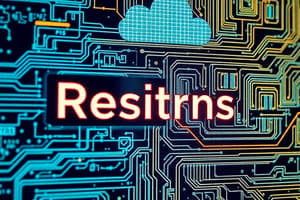Podcast
Questions and Answers
What is the main purpose of a system requirements document?
What is the main purpose of a system requirements document?
- To define the user requirements in natural language and diagrams
- To establish the timing constraints and development process for the system
- To outline the contract between the system buyer and software developers
- To provide a detailed description of the system's functions, services, and operational constraints (correct)
What is the difference between functional and non-functional requirements?
What is the difference between functional and non-functional requirements?
- Functional requirements state what the system should not do, while non-functional requirements state what the system should do
- Functional requirements describe the services the system should provide, while non-functional requirements are constraints on those services (correct)
- Functional requirements are written in natural language, while non-functional requirements use diagrams
- Functional requirements are for the system buyer, while non-functional requirements are for the software developers
Why is it important to write requirements at different levels of detail?
Why is it important to write requirements at different levels of detail?
- To provide a contract between the buyer and developers
- To ensure the system meets all user expectations
- Because different readers (e.g. users, developers) use the requirements in different ways (correct)
- To clearly define the functional and non-functional requirements
Which of the following is NOT a characteristic of a functional requirement?
Which of the following is NOT a characteristic of a functional requirement?
Which of the following is a key purpose of a system requirements document?
Which of the following is a key purpose of a system requirements document?
What is the main difference between user requirements and system requirements?
What is the main difference between user requirements and system requirements?
What does completeness mean in the context of functional system requirements?
What does completeness mean in the context of functional system requirements?
Which of the following factors can influence the requirements of a software system?
Which of the following factors can influence the requirements of a software system?
Why is it challenging to achieve both consistency and completeness in large, complex systems?
Why is it challenging to achieve both consistency and completeness in large, complex systems?
Which of the following is an example of a functional requirement for a mental health care patient management system?
Which of the following is an example of a functional requirement for a mental health care patient management system?
What does consistency mean in the context of functional system requirements?
What does consistency mean in the context of functional system requirements?
What is an example of a specific functional requirement mentioned in the text?
What is an example of a specific functional requirement mentioned in the text?
What is the primary purpose of requirements engineering?
What is the primary purpose of requirements engineering?
How is the term 'requirement' used in the software industry?
How is the term 'requirement' used in the software industry?
Why should requirements be written in an abstract way for a large software development project?
Why should requirements be written in an abstract way for a large software development project?
What should the contractor do after being awarded the contract?
What should the contractor do after being awarded the contract?
Which of the following statements is true about requirements documents?
Which of the following statements is true about requirements documents?
What is the purpose of writing a system definition in more detail by the contractor?
What is the purpose of writing a system definition in more detail by the contractor?
Flashcards are hidden until you start studying
Study Notes
Types of Requirements
- User requirements: natural language plus diagrams, describing services the system provides and operational constraints
- System requirements: detailed descriptions of software system’s functions, services, and operational constraints
Functional and Non-Functional Requirements
- Functional requirements: statements of services the system should provide, how it should react to inputs, and behave in situations
- May include explicit statements of what the system should not do
- Non-functional requirements: constraints on services or functions offered by the system, including timing constraints, development process constraints, and standards-imposed constraints
Functional Requirements
- Describe what the system should do
- Depend on software type, users, and organization approach
- Vary from general to specific requirements reflecting local ways of working or existing systems
- Examples for a mental health care patient management system:
- A user shall be able to search the appointments lists for all clinics
- The system shall generate each day, for each clinic, a list of patients expected to attend appointments that day
- Each staff member using the system shall be uniquely identified by their eight-digit employee number
Requirements Completeness and Consistency
- Functional requirements specification should be both complete (define all services required by the user) and consistent (no contradictory definitions)
- In practice, achieving completeness and consistency is impossible for large, complex systems
Requirements Engineering
- The process of finding out, analyzing, documenting, and checking services and constraints of a system is called requirements engineering (RE)
- The term "requirement" is not used consistently in the software industry, ranging from high-level abstract statements to detailed, formal definitions of system functions
Requirement Abstraction
- Requirements must be written in a sufficiently abstract way to allow for different solutions and bidding from contractors
- Once a contract is awarded, the contractor must write a more detailed system definition for the client to validate the software's functionality
Studying That Suits You
Use AI to generate personalized quizzes and flashcards to suit your learning preferences.




